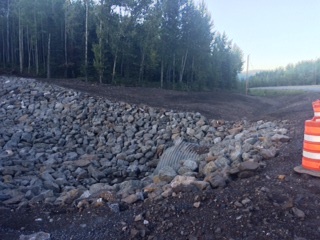
We continue to upgrade roads and bridges in the South Peace region, after major flooding in mid-June 2016. About 300 locations were hit by the flood, and in 2020, work continues as part of the Peace Flood Recovery program to replace bridges and culverts, to help them withstand future flooding events.

In July 2020, we replaced Rolla Road Bridge, east of Dawson Creek, with a two-lane, 50-metre-long bridge. In fall 2020, we expect to open a two-lane, 26-metre-long bridge across Fur Thief River, to replace a culvert west of Chetwynd. The 8th Street Bridge in Dawson Creek, where we’re replacing three culverts with a five-lane, 45-metre-long bridge over Dawson Creek, is expected to be complete in 2023.
Here’s a little of what goes into repairing roads and bridges, making them safe for you to travel again.
Restoring roads takes some or all of these 12 steps:
- Assessment – identifying all the factors in the damage, and what skilled people, supplies, and specialized equipment are needed to fix the problem.
- Getting the help there – making arrangements and/or entering into contracts to put the right resources into place (Yes, that’s paperwork – but it’s necessary to ensure we work with skilled and reputable companies that meet our standards).
- Coordinating utilities – locating and working safely around underground and overhead utilities that are close to the repairs, and within the road right of way, can mean involving utility companies.
- Removal of debris – re-routing water, and moving logs, rubble, mud and other debris elsewhere.
- Slope stabilization – reducing the possibility of rocks or mud from nearby slopes, from eroding and covering newly repaired road.
- Surveying – determining and staking out the road’s path while ensuring works are located within ministry property.
- Bridge and structures – assessing structural integrity, and depending on our findings, repairing the existing structure or installing a temporary structure.
- Compacting the ground – constructing a strong foundation where the road will be re-built.
- Putting down new layers of road – adding different gravel types in layers and compacting them before laying down pavement.
- Paving – applying paving materials in layers to provide a smooth, uniform and strong travelling surface.
- Line painting – laying down the lines that help keep you on the road and in your lane.
- Sign installation – choosing and erecting signs for safe navigation, indicating things like speed limits, curves, bridges or other warnings.

In early August 2016, there were close to 200 pieces of equipment on the job at repair sites. While a number of affected routes reopened July 19 of that year, there was still a lot of work to be done and our crews have been doing their best to repair and reinforce damaged sections since then to help prevent future damage.
Thank you for your patience and for helping everyone stay safe. Please drive carefully and obey all signage and traffic control people in work areas – our crews and big machines will be around for the next long while. Even though the highway might be open a week or so after a washout, ministry staff work for years afterward to mitigate against future events.
As always, know before you go by checking DriveBC for current planned events and future planned events (construction and road maintenance, plus things like parades or athletic events), incidents, road conditions and weather.

This blog was originally published in July, 2016
I live in this area and let me tell you these bridges are AWFUL!! Better slow down if you’re pulling a trailer!! There is no smooth seamless transition, they will send you flying. So bumpy and rough. Now I don’t know about building roads but wow! How many millions or billions of dollars were spent on these bridges?
Hello Raelene,
Thank you for commenting here and sharing your concerns. We shared your concern with our local area staff and they confirmed that due to the emergent nature of the works, the approaches could not be completed until recently. They would be happy to chat if you have more specific questions at 250-787-3237.
That’s amazing that you guys have almost 200 pieces of equipment on the job. I bet that helped out a lot. I can’t even imagine what it’s like fixing all those damaged sites. I wonder how long it takes them to repair all those roads and paths.
Depending on the extent of the damage and the time of year it happened it can take time. Thanks for connecting with us here!